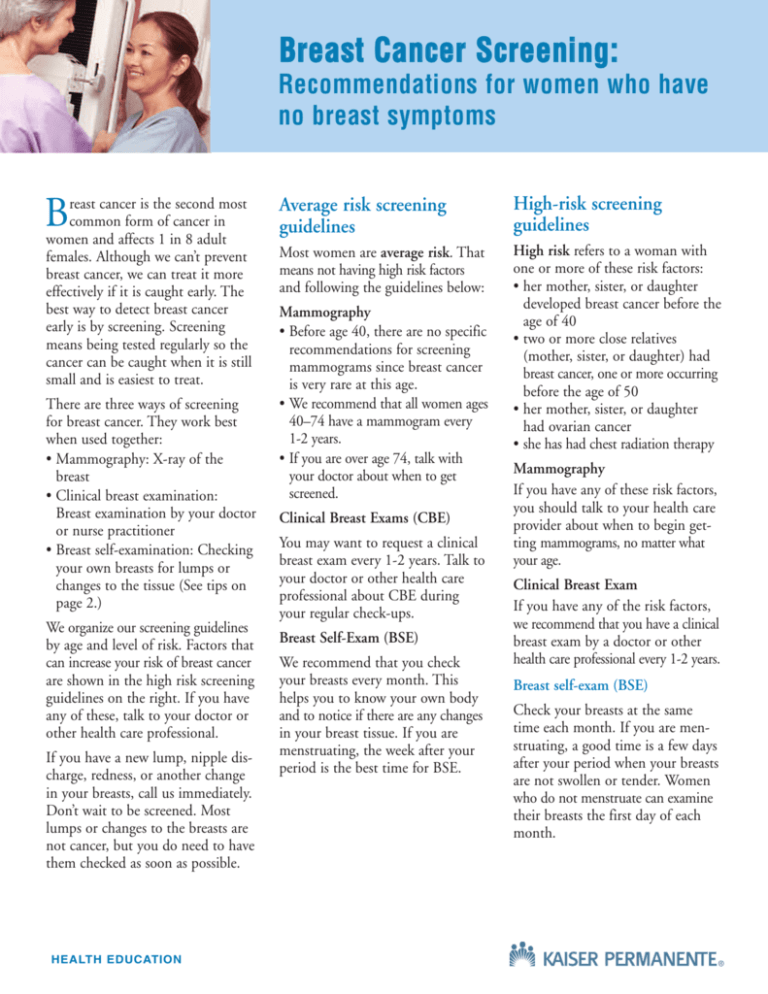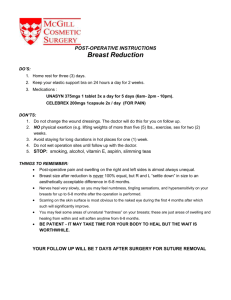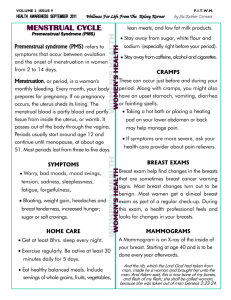
Br e a s t C a n c e r Sc r e e ni n g :
Recommendations for women who have
no breast symptoms
B
reast cancer is the second most
common form of cancer in
women and affects 1 in 8 adult
females. Although we can’t prevent
breast cancer, we can treat it more
effectively if it is caught early. The
best way to detect breast cancer
early is by screening. Screening
means being tested regularly so the
cancer can be caught when it is still
small and is easiest to treat.
There are three ways of screening
for breast cancer. They work best
when used together:
• Mammography: X-ray of the
breast
• Clinical breast examination:
Breast examination by your doctor
or nurse practitioner
• Breast self-examination: Checking
your own breasts for lumps or
changes to the tissue (See tips on
page 2.)
We organize our screening guidelines
by age and level of risk. Factors that
can increase your risk of breast cancer
are shown in the high risk screening
guidelines on the right. If you have
any of these, talk to your doctor or
other health care professional.
If you have a new lump, nipple discharge, redness, or another change
in your breasts, call us immediately.
Don’t wait to be screened. Most
lumps or changes to the breasts are
not cancer, but you do need to have
them checked as soon as possible.
HEALTH EDUCATION
Average risk screening
guidelines
High-risk screening
guidelines
Most women are average risk. That
means not having high risk factors
and following the guidelines below:
High risk refers to a woman with
one or more of these risk factors:
• her mother, sister, or daughter
developed breast cancer before the
age of 40
• two or more close relatives
(mother, sister, or daughter) had
breast cancer, one or more occurring
before the age of 50
• her mother, sister, or daughter
had ovarian cancer
• she has had chest radiation therapy
Mammography
• Before age 40, there are no specific
recommendations for screening
mammograms since breast cancer
is very rare at this age.
• We recommend that all women ages
40–74 have a mammogram every
1-2 years.
• If you are over age 74, talk with
your doctor about when to get
screened.
Clinical Breast Exams (CBE)
You may want to request a clinical
breast exam every 1-2 years. Talk to
your doctor or other health care
professional about CBE during
your regular check-ups.
Breast Self-Exam (BSE)
We recommend that you check
your breasts every month. This
helps you to know your own body
and to notice if there are any changes
in your breast tissue. If you are
menstruating, the week after your
period is the best time for BSE.
Mammography
If you have any of these risk factors,
you should talk to your health care
provider about when to begin getting mammograms, no matter what
your age.
Clinical Breast Exam
If you have any of the risk factors,
we recommend that you have a clinical
breast exam by a doctor or other
health care professional every 1-2 years.
Breast self-exam (BSE)
Check your breasts at the same
time each month. If you are menstruating, a good time is a few days
after your period when your breasts
are not swollen or tender. Women
who do not menstruate can examine
their breasts the first day of each
month.
Most women’s breast tissue has some
lumps or thickening. When in doubt
about a particular lump, check the
other breast. If you find a similar lump
in the same area on the other breast,
both breasts are probably normal. Be
on the lookout for changes, thickening,
or new lumps.
If you are unsure or have any areas of
concern, contact your medical professional by phone or email. The important
thing is to learn what is normal for you
and to report changes to your doctor.
How to do a breast self-exam
The breast self-exam takes place in
two phases.
Phase 1: In front of the mirror
Look at your breasts in a mirror. It is
normal for one breast to be slightly
larger than the other. Learn what is
normal for you.
Look at your breasts in three positions:
• Stand with your arms at your sides
• With your hands on your hips
• With your arms raised overhead
Pay attention to all tissue from the
collarbone to the armpit and from the
bra line to the breastbone. Start in the
armpit and work down to the bottom
of the bra line. Move one finger width
toward the middle and work up to the
collarbone. Repeat until you have covered
all the breast tissue.
Move the pillow or towel to the other
shoulder and repeat the steps for the
other breast.
In each position, look for changes in
the contour and shape of your breasts,
the color and texture of the skin and
nipple, and any discharge from the
nipples.
Phase 2: Lying down
To examine your left breast, place a
pillow or folded towel under your left
shoulder. Use your right hand to
examine your left breast. If your
breasts are large, lie on your right side
and turn your left shoulder back flat
so that the breast tissue spreads more
evenly over your chest wall. Use the
pads of your middle three fingers to
examine your breast. Move the fingers
in small, dime-sized circles. Don’t lift
your fingers away from the skin. Use
light, medium, and deep pressure in
each spot to feel the full thickness of
the breast tissue. You are feeling for
lumps, thickening, or changes of any
kind.
Examine your entire breast using a
vertical strip pattern (see illustration).
If you examine your breasts monthly,
you will learn what is normal for you
and quickly recognize if something
changes. The breast self-exam takes
some practice. You can learn more
about breast self-exams at your Kaiser
Permanente Health Education Center.
When to call Kaiser
Permanente
If you find any unusual lumps, thickening, discharge from the nipple, or
changes of any kind, call or email your
doctor immediately. Remember, most
lumps are not cancer, but you will
need your doctor to make a diagnosis.
Other resources
• Visit your doctor’s Home Page at
kp.org/mydoctor. Also, you can
search the Health Encyclopedia at
kp.org/health for more in-depth
information on this and many other
topics.
• Contact your Kaiser Permanente
Health Education Center or
Department for health information,
programs, and other resources.
This information is not intended to diagnose or to take the place of medical advice or care you receive from your physician or other health care professional.
If you have persistent health problems, or if you have additional questions, please consult with your doctor.
© 2008, The Permanente Medical Group, Inc. All rights reserved. Regional Health Education. This information sheet was developed by the Kaiser Permanente Northern
California Breast Cancer Task Force, Feb, 2008.
915800038 (Revised 5-10) RL 7.0








